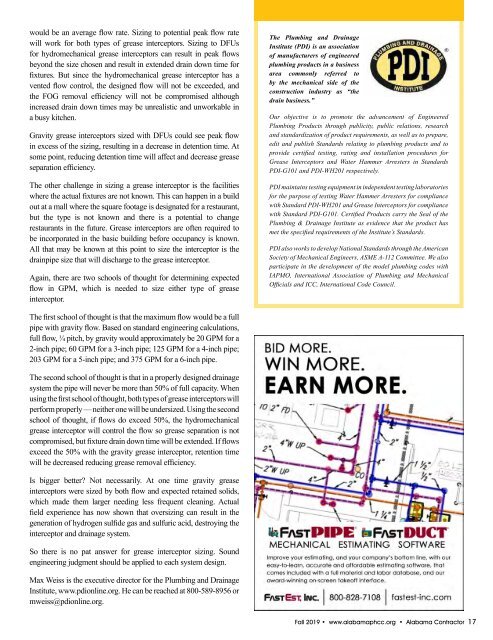Alabama Contractor Fall 2019
You also want an ePaper? Increase the reach of your titles
YUMPU automatically turns print PDFs into web optimized ePapers that Google loves.
would be an average flow rate. Sizing to potential peak flow rate<br />
will work for both types of grease interceptors. Sizing to DFUs<br />
for hydromechanical grease interceptors can result in peak flows<br />
beyond the size chosen and result in extended drain down time for<br />
fixtures. But since the hydromechanical grease interceptor has a<br />
vented flow control, the designed flow will not be exceeded, and<br />
the FOG removal efficiency will not be compromised although<br />
increased drain down times may be unrealistic and unworkable in<br />
a busy kitchen.<br />
Gravity grease interceptors sized with DFUs could see peak flow<br />
in excess of the sizing, resulting in a decrease in detention time. At<br />
some point, reducing detention time will affect and decrease grease<br />
separation efficiency.<br />
The other challenge in sizing a grease interceptor is the facilities<br />
where the actual fixtures are not known. This can happen in a build<br />
out at a mall where the square footage is designated for a restaurant,<br />
but the type is not known and there is a potential to change<br />
restaurants in the future. Grease interceptors are often required to<br />
be incorporated in the basic building before occupancy is known.<br />
All that may be known at this point to size the interceptor is the<br />
drainpipe size that will discharge to the grease interceptor.<br />
Again, there are two schools of thought for determining expected<br />
flow in GPM, which is needed to size either type of grease<br />
interceptor.<br />
The Plumbing and Drainage<br />
Institute (PDI) is an association<br />
of manufacturers of engineered<br />
plumbing products in a business<br />
area commonly referred to<br />
by the mechanical side of the<br />
construction industry as “the<br />
drain business.”<br />
Our objective is to promote the advancement of Engineered<br />
Plumbing Products through publicity, public relations, research<br />
and standardization of product requirements, as well as to prepare,<br />
edit and publish Standards relating to plumbing products and to<br />
provide certified testing, rating and installation procedures for<br />
Grease Interceptors and Water Hammer Arresters in Standards<br />
PDI-G101 and PDI-WH201 respectively.<br />
PDI maintains testing equipment in independent testing laboratories<br />
for the purpose of testing Water Hammer Arresters for compliance<br />
with Standard PDI-WH201 and Grease Interceptors for compliance<br />
with Standard PDI-G101. Certified Products carry the Seal of the<br />
Plumbing & Drainage Institute as evidence that the product has<br />
met the specified requirements of the Institute’s Standards.<br />
PDI also works to develop National Standards through the American<br />
Society of Mechanical Engineers, ASME A-112 Committee. We also<br />
participate in the development of the model plumbing codes with<br />
IAPMO, International Association of Plumbing and Mechanical<br />
Officials and ICC, International Code Council.<br />
The first school of thought is that the maximum flow would be a full<br />
pipe with gravity flow. Based on standard engineering calculations,<br />
full flow, ¼ pitch, by gravity would approximately be 20 GPM for a<br />
2-inch pipe; 60 GPM for a 3-inch pipe; 125 GPM for a 4-inch pipe;<br />
203 GPM for a 5-inch pipe; and 375 GPM for a 6-inch pipe.<br />
The second school of thought is that in a properly designed drainage<br />
system the pipe will never be more than 50% of full capacity. When<br />
using the first school of thought, both types of grease interceptors will<br />
perform properly — neither one will be undersized. Using the second<br />
school of thought, if flows do exceed 50%, the hydromechanical<br />
grease interceptor will control the flow so grease separation is not<br />
compromised, but fixture drain down time will be extended. If flows<br />
exceed the 50% with the gravity grease interceptor, retention time<br />
will be decreased reducing grease removal efficiency.<br />
Is bigger better? Not necessarily. At one time gravity grease<br />
interceptors were sized by both flow and expected retained solids,<br />
which made them larger needing less frequent cleaning. Actual<br />
field experience has now shown that oversizing can result in the<br />
generation of hydrogen sulfide gas and sulfuric acid, destroying the<br />
interceptor and drainage system.<br />
So there is no pat answer for grease interceptor sizing. Sound<br />
engineering judgment should be applied to each system design.<br />
Max Weiss is the executive director for the Plumbing and Drainage<br />
Institute, www.pdionline.org. He can be reached at 800-589-8956 or<br />
mweiss@pdionline.org.<br />
<strong>Fall</strong> <strong>2019</strong> • www.alabamaphcc.org • <strong>Alabama</strong> <strong>Contractor</strong> 17


















